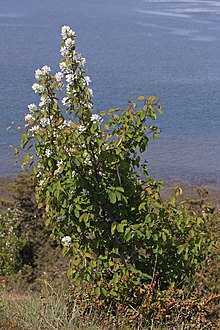Saskatoons
| Amelanchier alnifolia | |
|---|---|
 |
|
| A. a. var. semiintegrifolia; Skagit Bay, Washington | |
| Scientific classification | |
| Kingdom: | Plantae |
| (unranked): | Angiosperms |
| (unranked): | Eudicots |
| (unranked): | Rosids |
| Order: | Rosales |
| Family: | Rosaceae |
| Genus: | Amelanchier |
| Species: | A. alnifolia |
| Binomial name | |
|
Amelanchier alnifolia (Nutt.) Nutt. |
|
 |
|
| Natural range of Amelanchier alnifolia | |
| Synonyms | |
|
|
Amelanchier alnifolia, the saskatoon, Pacific serviceberry, western serviceberry, alder-leaf shadbush, dwarf shadbush, chuckley pear, or western juneberry, is a shrub with edible berry-like fruit, native to North America from Alaska across most of western Canada and in the western and north-central United States. Historically, it was also called pigeon berry. It grows from sea level in the north of the range, up to 2,600 m (8,530 ft) elevation in California and 3,400 m (11,200 ft) in the Rocky Mountains, and is a common shrub in the forest understory.
The name saskatoon derives from the Cree inanimate noun misâskwatômina (misâskwatômin NI sg, saskatoonberry, misâskwatômina NI pl saskatoonberries). The city of Saskatoon, Saskatchewan, is named after this berry.
The species name alnifolia is a feminine adjective. It is a compound of the Latin word for "alder", , and the word for "leaf", .
It is a deciduous shrub or small tree that most often grows to 1–8 m (3–26 ft), rarely to 10 m or 33 ft, in height. Its growth form spans from suckering and forming colonies to clumped.
The leaves are oval to nearly circular, 2–5 cm (3⁄4–2 in) long and 1–4.5 cm (1⁄2–1 3⁄4 in) broad, on a 0.5–2 cm (1⁄4–3⁄4 in) leaf stem, margins toothed mostly above the middle.
...
Wikipedia
